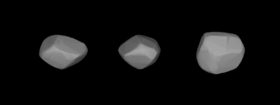64 Angelina
 Lightcurve-based 3D-model of Angelina | |
| Discovery | |
|---|---|
| Discovered by | Ernst Wilhelm Tempel |
| Discovery date | March 4, 1861 |
| Designations | |
MPC designation | (64) Angelina |
| Pronunciation | /ˌændʒəˈliːnə/ AN-jə-LEE-nə[2] |
Minor planet category | Main belt[1] |
| Adjectives | Angelinian (/ˌændʒəˈlɪniən/ AN-jə-LIN-nee-ən) |
| Orbital characteristics | |
| Epoch December 31, 2006 (JD 2454100.5) | |
| Aphelion | 451.375 Gm (3.017 AU) |
| Perihelion | 351.784 Gm (2.352 AU) |
| 401.580 Gm (2.684 AU) | |
| Eccentricity | 0.124 |
| 1606.452 d (4.40 yr) | |
| 107.758° | |
| Inclination | 1.308° |
| 309.285° | |
| 179.641° | |
| Physical characteristics | |
| Dimensions | 48 x 53 km[3] 52 ± 10 km[4] 60 x 53 x 45 km[5] |
| Mass | 1.5×1017 kg (assumed)[6] |
Synodic rotation period | 8.752 hr[1] (0.365 d) |
| 0.28 [7] 0.157 (IRAS)[1] | |
| E | |
Absolute magnitude (H) | 7.67 [1] |
Angelina (minor planet designation: 64 Angelina) is an asteroid from the central region of the asteroid belt, approximately 50 kilometers in diameter. It is an unusually bright form of E-type asteroid.
Discovery and naming[]
Angelina was discovered on March 4, 1861, by a prolific comet discoverer, E. W. Tempel, observing from Marseilles, France. It was the first of his five asteroid discoveries.
The naming of Angelina caused some controversy. It was chosen by Benjamin Valz, director of the Marseilles Observatory, in honour of the astronomical station of that name operated by Baron Franz Xaver von Zach on the mountains above the city. At the time, asteroids were supposed to receive names from classical mythology, and several astronomers protested the choice. Tempel noted that if the second 'n' were removed, the complaints would be satisfied (referring to Angelia, a minor Greek deity). However, Valz's choice stayed.[8]
Physical characteristics[]
Angelina is an uncommon form of E-type asteroid; it is the third largest E-type after 44 Nysa and 55 Pandora, and has an exceptionally high albedo.[9] As of 1991, it is thought to have an average radius of about 30 kilometers (19 mi).[10] Back when asteroids were generally assumed to have low albedos, Angelina was thought to be the largest of this class, but modern research has shown that its diameter is only a quarter of what was previously assumed, an error caused by its exceptional brightness. Traditional calculations had suggested that since Angelina has an absolute magnitude of 7.7 and an albedo of 0.15,[1] its diameter would have been around 100 km. However, a 2004 occultation showed a cross-sectional profile of only 48x53 km.[3] Angelina was observed by Arecibo radar in January 2010.[5]
References[]
- ^ a b c d e "JPL Small-Body Database Browser: 64 Angelina". Retrieved 5 September 2010.
2010-06-01 last obs
- ^ "Angelina". Oxford English Dictionary (Online ed.). Oxford University Press. (Subscription or participating institution membership required.)
- ^ a b David Dunham (2–3 July 2004). "IOTA Meeting, Apple Valley, Calif". IOTA. Retrieved 21 February 2007.
- ^ Ďurech, Josef; Kaasalainen, Mikko; Herald, David; Dunham, David; Timerson, Brad; Hanuš, Josef; et al. (2011). "Combining asteroid models derived by lightcurve inversion with asteroidal occultation silhouettes" (PDF). Icarus. 214 (2): 652–670. arXiv:1104.4227. Bibcode:2011Icar..214..652D. doi:10.1016/j.icarus.2011.03.016. S2CID 119271216. Archived from the original (PDF) on 3 March 2016. Retrieved 26 January 2012.
- ^ a b Shepard, Michael K.; Harris, Alan W.; Taylor, Patrick A.; Clark, Beth Ellen; Ockert-Bell, Maureen; Nolan, Michael C.; et al. (2011). "Radar observations of Asteroids 64 Angelina and 69 Hesperia" (PDF). Icarus. 215 (2): 547–551. arXiv:1104.4114. Bibcode:2011Icar..215..547S. doi:10.1016/j.icarus.2011.07.027. S2CID 119290080.
- ^ Using a spherical radius of 26 km; volume of a sphere * density of 2 g/cm3 yields a mass (m=d*v) of 1.472E+17 kg
- ^ Morrison, D.; Chapman, C. R. (1976). "Radiometric diameters for an additional 22 asteroids". Astrophysical Journal. 204: 934–939. Bibcode:1976ApJ...204..934M. doi:10.1086/154242.
- ^ Schmadel, Lutz D. (2003). Dictionary of Minor Planet Names. Springer Science & Business Media. p. 21. ISBN 978-3-540-00238-3.
- ^ Kiselev, N.N; Shakhovskoy, N.M; Efimov, Yu.S (1996), "On the Polarization Opposition Effect of E-Type Asteroid 64 Angelina", Icarus, 120 (2): 408, Bibcode:1996Icar..120..408K, doi:10.1006/icar.1996.0060
- ^ Lionel Wilson and Klaus Keil - Explosive Eruptions on Asteroids: The Missing Basalts on the Aubrite Parent Body - Abstracts of the Lunar and Planetary Science Conference, volume 22, page 1515, (1991)
External links[]
- 2004 Angelina occultation (cross-sectional profile of 48x53 km)
- 64 Angelina at AstDyS-2, Asteroids—Dynamic Site
- 64 Angelina at the JPL Small-Body Database

- Minor planet object articles (numbered)
- Background asteroids
- Discoveries by Wilhelm Tempel
- Minor planets named for places
- Named minor planets
- E-type asteroids (Tholen)
- Xe-type asteroids (SMASS)
- Astronomical objects discovered in 1861